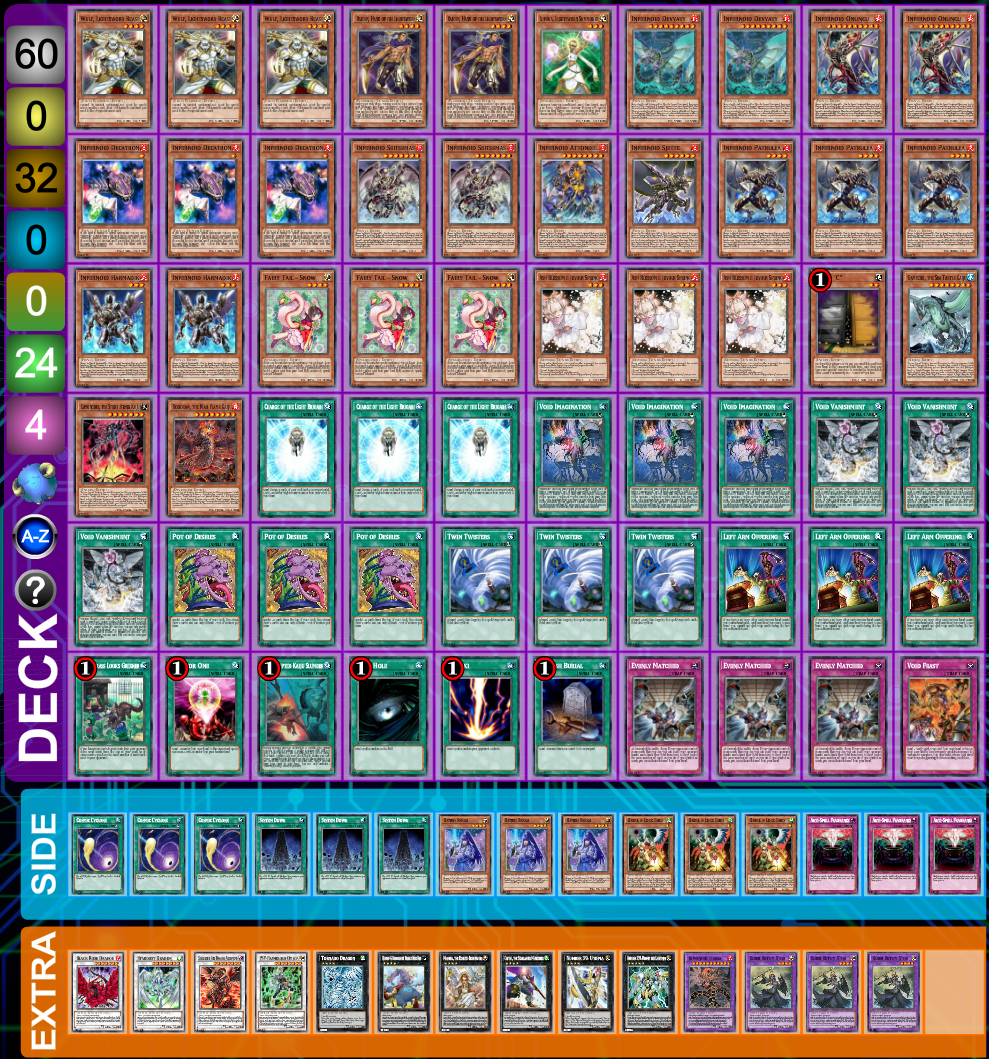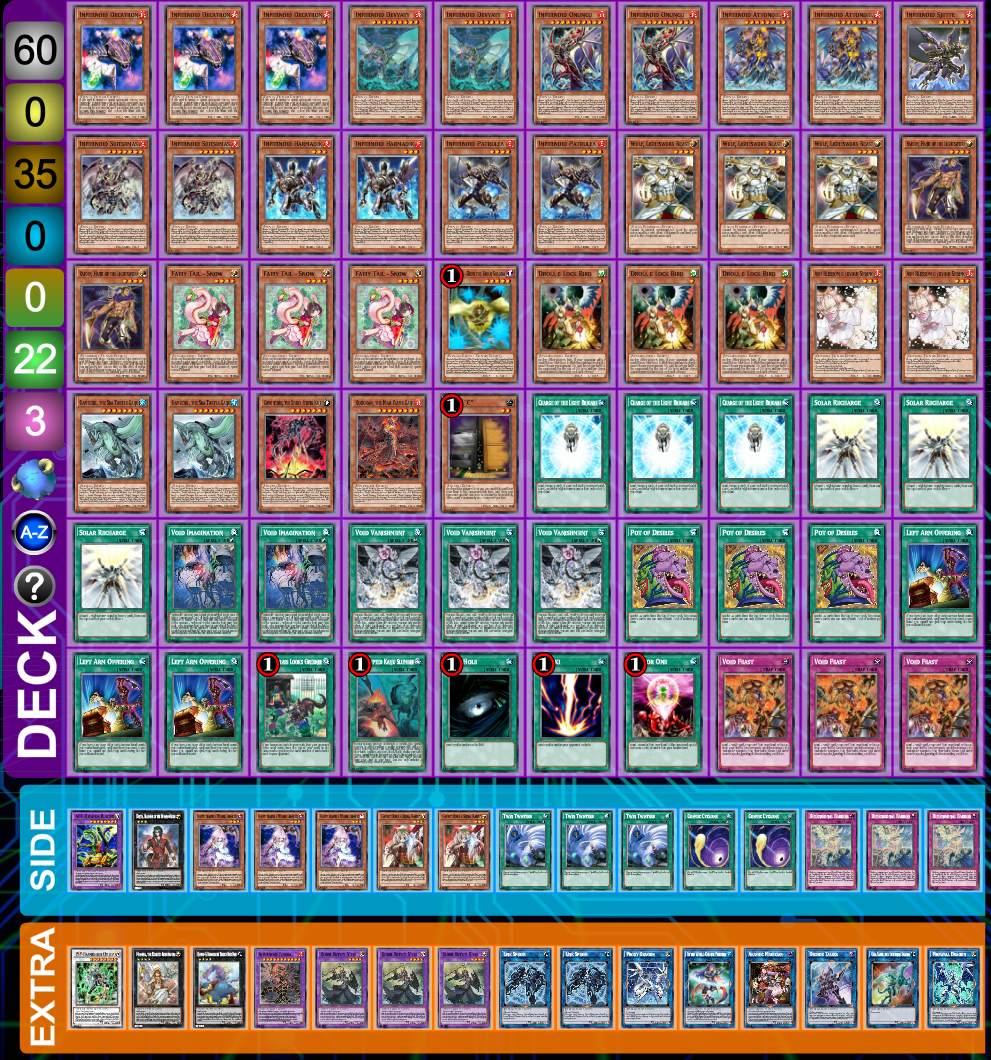Tier 1: Highly Competitive Meta Decks. 10% or more of tops, as ranked by Pojo. This will roughly correspond to Pojo’s Tier 1, with some overlap into Pojo’s Tier 2.
Tier 2: Semi-Competitive Meta Decks. Less than 10% of tops, as ranked by Pojo. Corresponds to the rest of Pojo’s Tier 2, Pojo’s Tier 3, and Rogue.
Tier 3: Semi-Competitive non-Meta/Rogue decks. 1-2 tops. Specifically includes decks that top small events or get lower rankings at medium events. Can also include decks that can potentially top but have not yet in a given format.
Tier 4: Casually Competitive non-Meta decks. Decks that can compete at the locals level, but cannot top an event.
Archetype Explanation
Infernoids are a deck that first became competitive in 2015. They have stayed relevant to some degree through the use of various techs and engines since then. The deck's play style revolves around milling their own deck in order to get a large number of Infernoid monsters in the Graveyard. These monsters can then be banished to summon out the very powerful high level Infernoid monsters such as Infernoid Devyaty or Infernoid Onuncu. The deck generally focuses more on breaking opposing boards instead of making their own unbreakable boards, but more recent support such as Void Feast allows them to also go first by getting multiple negates.
Tier Ranking
Although the November 2017 Forbidden List format hasn't fully taken shape yet, Infernoids have steadily proven themselves as a viable contender on the edges of the meta. Since the release of Circuit Break, the deck has gotten a handful of tops at regionals and most recently Top 16 at the first ARG run under the new Forbidden List. All things considered, this places Infernoids near the bottom of Tier 2.
Decklists
There are several variants of Infernoids that are usable, but the only variant that has seen competitive success recently has been the 60 card Lightsworn variant. The two lists we will be looking at are the Top 16 Lightsworn Infernoid list from ARG CS St. Louis on November 4-5 and the 3rd Place London Mega Regionals list.

The first list we're looking at is the Lightsworn Infernoid decklist that got 3rd place at the YCS London Mega Regionals on October 28. The deck has a few interesting choices that merit going over. The first of these are in the Lightsworn line-up. While the general philosophy behind a Lightsworn engine in Infernoids in the past has been to run as few Lightsworn monsters as possible, this list chose to run 6. Lumina is useful due to her allowing for both easier Link summons and a quick Black Rose Dragon while also allowing more consistent usage of Raiden even after he's sent to the Graveyard.
Running 3 Wulf is also very strong due to its synergy with That Grass Looks Greener. Wulf gives the mills from That Grass Looks Greener immediate value that they might not otherwise have if only Infernoid monsters were being milled.
The Infernoid lineup in this list is relatively standard with the only non-standard ratio being the inclusion of only 2 copies of Infernoid Seitsemas which is usually ran at 3 in most competitive Infernoid builds. The Void Spell and Trap lineup is also relatively standard except for the interesting choice of including only a single copy of Void Feast. While Void Feast is an extremely powerful card, this particular variant of the deck focuses more on going second making Void Feast non-essential to the deck's strategy. This separates it somewhat from the much more Void Feast focused builds that we had seen earlier in the year during Zoodiac format.
Outside of the core engine cards, this list also runs a decent number of cards specifically for going second. These include running the max number of board wipes including Raigeki, Dark Hole, Interrupted Kaiju Slumber, and 3 copies of Evenly Matched in the main deck. Altogether, these cards almost guarantee that the deck will be able to break the opponent's board when going second.

This second list is Alex Simpson's 60 Card Lightsworn Infernoid deck that got Top 16 at the ARG CS St. Louis on November 4-5. The list has a lot of similarities to the Mega Regionals list, but with several notable tweaks in regards to ratios and tech choices. The first of these is to the Lightsworn engine itself. Simpson opted not to play Lumina, but further expanded the Lightsworn engine in the deck by playing 3 copies of Solar Recharge.
Playing Solar Recharge theoretically gives the deck less bricks in regards to having too many Lightsworn monsters in hand. While Raiden is a very good card, its need to be Normal Summoned can often conflict with Infernoid Decatron. Solar Recharge gives an outlet for generating advantage off of these cards when they would otherwise be dead in the hand.
The next interesting choice was Simpson's slightly lower number of hand traps, only opting to main deck 2 copies of Ash Blossom and 1 Maxx "C". This goes very much in the opposite direction from the general philosophy of the format to run as many hand traps as possible. However, with the deck's focus on milling, hand traps lose much of their normal luster.
The Infernoid lineup that Simpson chose to run is relatively standard and is complemented by a full Void Spell and Trap lineup, with 3 copies of Void Vanishment and Void Feast as well as 2 copies of Void Imagination. These ratios are much more targeted at actually resolving Void Feast than the Mega Regionals list which is definitely a viable choice considering how powerful Void Feast is when properly resolved.
Tech Choices
One of the biggest tech options for Infernoids going forward will definitely be Fire King Avatar Arvata. This card is a level 4 Beast-Warrior, making it searchable by Fire Formation Tenki. Its effect allows for non-once per turn negation of effects, so long as you have FIRE monsters in hand or on the field besides Arvata. The price of this negation is to destroy the monsters, but considering how Infernoids can be summoned and/or used as resources from the Graveyard, this cost is largely mitigated.
A similar choice to Fire King Avatar Arvata is Amano-Iwato. This a Spirit monster that offers blanket prevention of monster effects from non-Spirit monsters at no cost. The main drawback to the card is that it is a Spirit monster itself, so it can only offer protection from effects during your own turn. Amano-Iwato also needs to be Normal Summoned every turn if its effect negation is still desired. These drawbacks combined with the card's low level of searchability when compared to Arvata make it the weaker choice between the two.
Another very viable tech option is the inclusion of PSY-Framegear Gamma. This hand trap can negate monster effects so long as you have an empty field. It can be particularly useful as a counter for Ash Blossom & Joyous Spring when it used against your That Grass Looks Greener or Void Feast.
Matchups
SPYRAL
Although the November 2017 Forbidden List dropped the deck's consistency, SPYRAL is looking like it will remain very solidly at the top of the meta. Fortunately, Infernoids already had a relatively good SPYRAL matchup and the Forbidden List only improves it. When going second, breaking the opponent's board should be relatively easy if a board wipe and a Kaiju can be used in tandem to get past SPYRAL Sleeper and/or Tri-Gate Wizard. Going first, the deck is very powerful as Void Feast can offer up sufficient negates to stop SPYRAL from getting off the ground while the general Graveyard banishing effect of the lower level Infernoid monsters can be particularly deadly in banishing the opponent's only copy of Quik Fix or Drone.
The best cards to side against the deck haven't really changed from the previous format, consisting primarily of hand traps such as Ghost Reaper & Winter Cherries and Droll & Lock Bird. Evenly Matched is also particularly effective now that Set Rotation is Limited.
Trickstar
Trickstars have been consistently proving themselves as a high level contender in the post-Circuit Break meta, so they should be accordingly planned for. Going second against Trickstars can be particularly dangerous considering the risk of getting your entire hand removed by Trickstar Reincarnation and Droll & Lock Bird. However, barring that combo, many of Trickstar's normal tactics can prove less than effective against Infernoids. As Infernoids primarily focuses on milling instead of searching, Trickstar Lycoris will burn less and Droll & Lock Bird will be far less effective.
The main counters that can be made against the deck are more hand traps and backrow removal such as Twin Twisters to reduce hand size and force out their trap cards.
Pendulum Magicians
Pendulum Magicians have a variable matchup against Infernoids. The fact that the deck's removal and negation usually banishes is very helpful in dealing with Magicians. However, the fact that Magicians don't use the Graveyard nullifies the benefits offered by the generic Infernoid effect to banish from the Graveyard. Time Pendulumgraph can also be extremely dangerous if used correctly due to the relatively low number of monsters that Infernoids can usually put onto the board without successfully resolving either That Grass Looks Greener or Void Feast.
To counter the deck, backrow removal such as Twin Twisters and/or Cosmic Cyclone are highly recommended. Anti-Spell Fragrance can also be a reasonable side deck inclusion as it will completely shut Magicians off, usually for long enough that you can generate a sizable amount of card advantage.
Burning Abyss
The Burning Abyss matchup has always been very good for Infernoids. This is primarily due to the shared effect amongst all low level Infernoids to banish a card from the opponent's Graveyard as a quick effect. This effect, especially in the regions of the TCG that adhere to North American rulings, can be particularly deadly. This is because In North america, cards that require being sent to a specific location (in this case the Graveyard) to trigger, must still be in that location when attempting to activate their effects. This means that if Dante, Traveler of the Burning Abyss mills a Burning Abyss monster as cost for its effect, an Infernoid monster can chain to Dante and banish that Burning Abyss monster, meaning it won't be able to resolve its effect.
Outside of this ruling, the Infernoids can also be used to banish the targets of Dante and Cir before they can be recycled. This can be especially deadly when banishing a Burning Abyss player's only copy of Cir or Graff. Overall, there really aren't any specific cards that really need to be sided against Burning Abyss.




